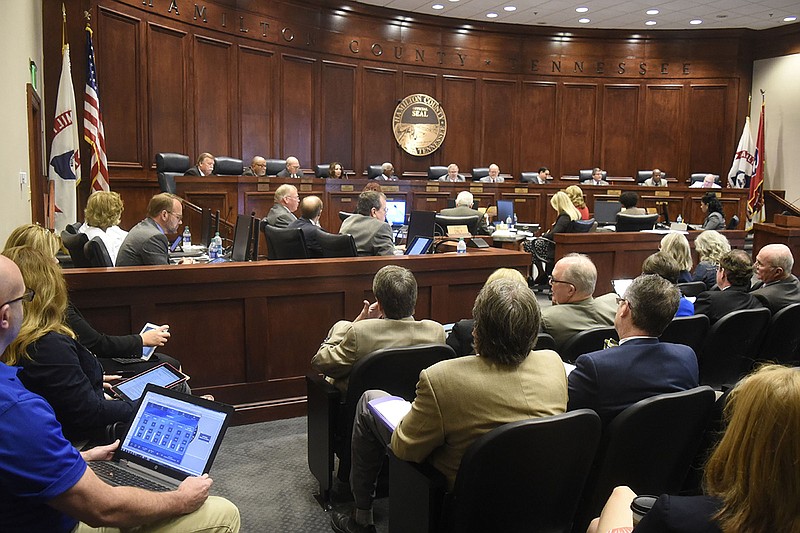A community activist's question about boundaries for new Opportunity Zones eligible for federal tax credits sparked a discussion Wednesday at the Hamilton County Commission.
The Opportunity Zone program targets specific underdeveloped census tracts and gives tax breaks to developers who invest in them. In Tennessee, the zone boundaries were set by county mayors and approved by Gov. Bill Haslam early this year.
Helen Burns Sharp, with the group Accountability for Taxpayer Money, asked during the commission's public comment period why most of the census tracts in Hamilton County's Opportunity Zones were in already developing areas rather than left-behind neighborhoods.
Developers already active in areas such as downtown, M.L. King Boulevard and South Broad Street "might not have needed an opportunity zone incentive to convince them to move forward with their plans," Sharp said. "On the other hand, the incentive might have been a determining factor to persuade someone to invest in a real low-income neighborhood" such as East Chattanooga, Avondale, Glenwood and Brainerd.
"Neighborhood leaders wonder, too, if this might have spurred development, such as the building of a grocery store in the East Chattanooga-Avondale area," she said.
Sharp acknowledged the county was under a tight deadline to submit its proposed zones - the Times Free Press reported in August that Mayor Jim Coppinger had less than a month to assemble the county's list of 17 tracts.
But, she added, "I hope the lesson learned from this experience is that the selection committee for a program such as this should include representation from neighborhoods that could or would be impacted."
She also said the county now has the opportunity to develop policies that would help residents of Opportunity Zone neighborhoods using tools such as community benefit agreements. Such customized agreements might commit developers to any number of initiatives, from affordable housing to targeted job training or partnerships with local schools.
"It's something a lot of places do when incentives come in, in order to give a little shot in the arm to some areas that are impacted," she said.
Coppinger defended the process as inclusive and transparent.
"We contacted all 10 municipalities, either their city managers or their mayors, and said, is there any specific area that you'd like to see included?" he said, adding that the city of Chattanooga "played an integral part in the selection process."
The county had to hustle to get its list in before the March 23 deadline, he said. And then when it did, the state extended the submission date to April 20 for other counties.
The opportunity for input "might not have reached every group that some people think that it should have, but if we'd had more time maybe we would have been able to do that. But again, I think we did get a broad group of people to do this. It wasn't just the county mayor that was putting this together," he said.
In the end, the county submitted 17 census tracts; seven were awarded Opportunity Zone status.
Commissioner Warren Mackey noted that the city has lots of "substandard" housing in places such as East Chattanooga and Orchard Knob and wondered if the incentives will go where they're most needed.
"Going forward, is there a way that more people, more voices can be brought to the table to address who we are going to incentivize?" Mackey asked.
"I realize government is not going to build a grocery store, government is only going to do certain kind of things, but at the same time there's a lot of people in Hamilton County who need decent housing. Whatever we can do to help people live better lives is something I think we need to give strong consideration to," he said.
Coppinger replied that though the zones might have some fast-growing areas, each also contains low-income and underdeveloped areas.
The downtown Innovation District is centered in the Edney Building at Market and 11th streets, which is directly across the street from the Patten Towers low-income high-rise. The Westside zone is home to the upscale Cameron Harbor complex, but it also includes College Hill Courts and senior and low-income apartments.
Commissioner Tim Boyd said he learned about the Opportunity Zone program during a trip to Washington, D.C., and said he's looking forward to seeing how it stimulates investment in the target areas.
"It's going to be overall good for the county," Boyd said.
Leadership swap
The first order of business Wednesday was to choose a chairman and chair pro tem for the new commission. The day also saw the first votes for three new commissioners: Chip Baker in District 2, Katherlyn Geter in District 5 and David Sharpe in District 6.
Commissioners opted for a leadership swap, keeping Randy Fairbanks and Sabrena Smedley in the top posts but swapping their roles.
Smedley, the vice chairwoman in the prior commission, was the only nominee for chair and was elected 8-0. Boyd passed on the vote.
Fairbanks was nominated along with Chester Bankston and Greg Martin for the vice chairman slot. Bankston was eliminated on the first ballot and Fairbanks got seven votes to Martin's two in the second round.
Contact staff writer Judy Walton at jwalton@timesfreepress.com or 423-757-6416.
